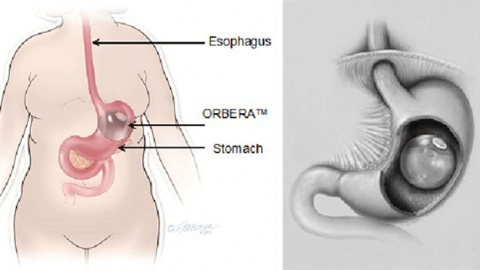Guide to Gastric Balloons
Reviewed by the physicians of Columbia’s Weight Loss Surgery Team, February 2024
What are Gastric Balloons?
Gastric balloons (also called intragastric or stomach balloons) are temporary, removable devices that are placed in the stomach by endoscopy (through the mouth) and can remain for up to six months. Patients with a BMI above 30 are eligible for gastric balloons. In some cases they may be appropriate for patients with a BMI as low as 27.
How do Stomach Balloons Help People to Lose Weight?
Endoscopically placed balloons help to achieve weight loss by taking up space in the stomach, thereby restricting food intake.
Benefits of Gastric Balloons
Endoscopically placed stomach balloons may be considered a middle ground between medications and surgery. They offer the following advantages:
- No medications
- No surgery
- Less expensive than surgical options
- Devices are temporary and procedures are reversible
- Available to patients who may not be eligible for weight loss surgery
Are Gastric Balloons Approved and Available?
The Orbera™ Balloon, approved in the U.S. in August 2015, is an endoscopically (scope through the mouth) placed saline (salt-water) filled device that contains 500-750 mL (24-36 ounces) of fluid. It has been approved by the FDA for placement for up to six months. The balloon is placed by highly experienced gastrointestinal endoscopists or surgeons under monitoring by anesthesiologists. The estimated length of the outpatient procedure is 20-40 minutes. No later than six months after placement, the stomach balloon is removed during a similar endoscopic procedure.

Benefits of Orbera
Orbera has been placed in thousands of patients in Europe and other parts of the world. Large clinical studies have evaluated the efficacy and safety of this device, and these have demonstrated great efficacy with rare reported adverse events. In some of the largest studies, which have included up to 3000 patients, the estimated weight loss was over 30 pounds at six months — about 15% of body weight — or a decrease of nearly five BMI (body mass index) points. Although less well studied, some studies showed the weight loss balloon resulted in significant improvement in conditions associated with obesity, including diabetes and cardiovascular health. The stomach balloon also improved patients’ lipid levels and blood sugar levels (Hemoglobin A1C). Although the gastric balloon is temporary and is removed after six months, patients experienced continued weight loss six months after removal. That benefit also continued in a small fraction of patients who have been followed for over five years after balloon removal.
Risks of Orbera
Several studies have evaluated the side effects of intragastric balloon placement. Immediate side effects such as discomfort, nausea and vomiting were noted in a minority of patients (0.8-4%). Overall 4.2% of patients had the gastric balloon removed early for intolerance. Rare serious side effects such as migration and bowel obstruction or perforation occurred in 0.1-0.8% of cases respectively.
The ReShape Duo and Obalon balloons also have FDA approval, and although their design and volume differ, the goal of this therapy is similar.
Is a Gastric Balloon Right for Me?
To determine whether a stomach balloon may be an appropriate part of your weight loss therapy plan, the Center for Metabolic and Weight Loss Surgery conducts a comprehensive evaluation. Together with each patient, our team develops a plan of care based upon each patient’s history and health conditions, and considers medical, endoscopic, and surgical options as appropriate.
Related Topics
- Sleeve Gastrectomy
- Gastric Bypass Surgery
- Laporoscopic Gastric Banding
- Revisional Surgery
- Duodenal Switch
- Endoscopic Procedures
- Metabolic Analysis
Stories & Perspectives
In Their Own Words: Patients Describe Their Transformations
Next Steps
Ready for a change? To get started with our program, call (212) 305-4000 or request an appointment online today.
